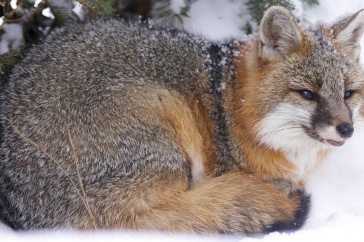UNH Vet Lab Finds Listeria in Wild Gray Foxes in New Hampshire

Listeria has been found in two New Hampshire wild gray foxes by investigators at the New Hampshire Veterinary Diagnostic Laboratory at the University of New Hampshire. Credit: Vermont Fish and Wildlife Department.
DURHAM, N.H.—Investigators at the New Hampshire Veterinary Diagnostic Laboratory at the University of New Hampshire have found Listeria in two New Hampshire wild gray foxes. A zoonotic disease, the bacterium can sicken both people and farm animals. Some strains can be particularly important if they are resistant to multiple antibiotics and carry genes that lead to more severe diseases in infected people or animals.
“Listeria is a reportable disease to both human and veterinary state public health officials and is one big reason why pregnant women shouldn’t eat cold cuts and soft cheeses,” said David Needle, senior veterinary pathologist and associate clinical professor with the laboratory.
Through genetic analysis, the investigators found that the disease in one of the foxes was resistant to multiple antibiotics and was highly virulent.
“This is important as we have seen an increase in Listeria diagnoses at the lab. These foxes are part of that picture, but exactly how we don’t know yet,” said Needle. “However, the antibiotic resistance indicates that there is an ongoing need to test animals for resistance, as well as a need to fund research into resistance across human and animal medicine.”
According to Patrick Tate, a wildlife biologist with New Hampshire Fish and Game, antibiotic resistance is an important measure to track because some pathogens are zoonotic diseases or can become zoonotic. “Zoonotic pathogens have the ability to significantly impact human health, impact agricultural animals and cause significant impact to the food supply chain.”
New Hampshire State Veterinarian Stephen Crawford noted the use of antibiotics in food animal medicine is very tightly regulated. Regulating access to antibiotics can only do so much. Public messaging campaigns have targeted physicians, veterinarians, and their patients and clients in the past several years. Client compliance with proper prescription use and inappropriate disposal of unused antibiotics such as flushing down the toilet and giving to other people both present risks to the development of bacterial resistance. “Clearly, antibiotic resistant organisms can make their way into wildlife and the environment through many routes, and likely back to both humans and domestic animals, as well. We all need to continue to do our best to be judicious in our choices of if, when, and what to use as antibiotic therapies.”
In the 33 months since the first fox submission, the veterinary diagnostic lab has diagnosed Listeria monocytogenes in 15 animals. In the 48 months prior to this, just three cases of Listeria were diagnosed. The 15 animals recently diagnosed include 10 goats, two sheep, one cow, and the two foxes.
“It is important that we found Listeria monocytogenes in these two foxes as they are free-ranging, wild animals carrying and infected by a bacterium that causes disease in farm animals and people. We have not had the diagnosis in a wild animal prior to these two cases. It is of potentially increased importance since we have been seeing a significant increase in Listeria in farm animals at the same time as in these wild foxes,” Needle said.
"People should not interact with wildlife and they should vaccinate their pets and livestock as their veterinarian recommends. Interactions with wildlife are best left to professionals – any suspicious, aggressive, or ill wildlife should be reported to New Hampshire Fish and Game, who will triage and assign appropriate personnel to address any perceived threat,” Needle said.
This research is reported in the journal Pathogens. It is supported by the New Hampshire Agricultural Experiment Station and the State of New Hampshire.
As part of the NH Agricultural Experiment Station at UNH, the New Hampshire Veterinary Diagnostic Laboratory serves the state of New Hampshire as a key partner with the New Hampshire Commissioner of Agriculture and State Veterinarian in their efforts to monitor and control important animal diseases. The lab also provides diagnostic services to hundreds of veterinarians from New Hampshire and New England who use the lab’s services for the diagnosis of animal diseases in pets, farm animals, wildlife, zoo and marine animals.
The University of New Hampshire inspires innovation and transforms lives in our state, nation and world. More than 16,000 students from all 50 states and 71 countries engage with an award-winning faculty in top-ranked programs in business, engineering, law, health and human services, liberal arts and the sciences across more than 200 programs of study. As one of the nation’s highest-performing research universities, UNH partners with NASA, NOAA, NSF and NIH, and receives more than $110 million in competitive external funding every year to further explore and define the frontiers of land, sea and space.
PHOTO AVAILABLE FOR DOWNLOAD
https://colsa.unh.edu/nhaes/sites/default/files/media/images/grayfox.jpg
Listeria has been found in two New Hampshire wild gray foxes by investigators at the New Hampshire Veterinary Diagnostic Laboratory at the University of New Hampshire. Credit: Vermont Fish and Wildlife Department.
Latest News
-
July 9, 2024
-
July 2, 2024
-
June 18, 2024
-
June 18, 2024
-
May 17, 2024


















































